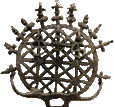| |
ÖZET
Soru, dillerde yer değiştirme, ekler, parçacıklar ya da kelimeler gibi dil bilgisel araçlarla oluşturulur. Soru yapımı araçları bakımından oldukça zengin olan Kırgız Türkçesinde sorular temel olarak soru parçacıkları, soru kelimeleri ve vurgu vasıtasıyla yapılır. Kırgız Türkçesinde soru cümlesi türleri olarak E/H soruları, nk-soruları, onay soruları, seçmeli sorular, yansımalı sorular, retorik sorular ve bildirme soruları yer alır. Nk-soruları kim “kim”, emne “ne”, kayda “nerede”, kanday “nasıl” gibi soru kelimeleriyle yapılır. Hiçbir soru unsuru içermeyen, sadece ilgili bağlam ve vurguyla yapılan nk-soruları da vardır. Kırgız Türkçesinde nk-sorularının basit ve çoklu nk-soruları, olumlu ve olumsuz nk-soruları, yansımalı nk-soruları, retorik nk-soruları, nk-ünlem cümleleri ve nk-bildirme soruları gibi türleri vardır. Kırgız Türkçesinde nk-sorularının temel işlevi soru sormak ve bilgi almaktır. Ancak nk-soruları, soru yanında öfke, sevgi, merak, tehdit, övgü, şüphe, küçümseme, alay, emir, rica vb. anlamları da bildirebilir.
ANAHTAR SÖZCÜKLER
Kırgız Türkçesi, Soru cümleleri, Nk-soruları, Nk-kelimeleri.
ABSTRACT
Questions in languages are formed through a variety of linguistic tools such as relocation, insertions, particles or word. In Kyrgyz Turkish, which is quite rich in terms of the tools of forming question, the question are basically formed through particles of questions, question words and emphasis. In Kyrgyz Turkish the types of question sentences are Y/N (Yes/No) questions, wh- questions, tag questions, alternative questions, echo questions, rhetorical questions and declarative questions. Nk- questions are formed through the question word: kim “who”, emne “what”, kayda “where”, kanday “how” and so on. There are also types of nk-questions which do not contain any elements of question and just formed through the context and emphasis. In Kyrgyz Turkish there are the types of wh-questions such as simply and multiple wh-questions, negative and positive wh-questions, echo wh-questions, rhetorical wh-questions, wh-exclamative phrase and declarative wh-questions. The primary function of the question sentences in Kyrgyz Turkish is to ask questions and acquire information. But besides question, the question sentences may also report meaning such as anger, love, curiosity, threat, praise, doubt, scorn, ridicule, command, desire etc. as well.
KEY WORDS
Kyrgyz Turkish, Interrogatives, Nk-questions, Nk-words.
KAYNAKLAR / BIBLIOGRAPHY
ABDUVALİYEV İ., T. SADIKOV, (1997), Azırkı Kırgız Tili, Bişkek.
AKAR Didar, (1990), Wh-Questions in Turkish, Boğaziçi Üniversitesi SBE, Yüksek Lisans Tezi, İstanbul.
ARSLAN Zekiye Ceyda, (1999), Approaches to Wh-Structures in Turkish, Boğaziçi Üniversitesi SBE, Yüksek Lisans Tezi.
BARNES Julia D., (2006), Early Trilingualism: A Focus on Questions, Multilingual Matters.
BARTELS Christine, (1999), The Intonation of English Statements and Questions: A Compositional Interpretation, Garland Publication.
BELL Martin, (1975), “Questioning”, The Philosophical Quarterly, C. 25, S. 100, 193-212.
BOLINGER Dwight, (1975), Aspects of Language, New York.
BOUDIER C.E.M. Struyker, (1988), “Toward a History of the Question”, in Questions and Questioning, ed. Michel Meyer, Berlin, New York, 9-35.
BROWN K., J. MİLLER, (1996), Concise Encyclopedia of Syntactic Theories, Cambridge University Press.
CAPAROV A., (1979), Kırgız Tilinin Sintaksisi, Frunze.
GINZBURG J., (1992), “Questions Without Answers, Wh-Phrases Without Scope: A Semantics for Direct Wh-Questions and Their Responses”, in Stuation Theory and its Applications, Robin Cooper, Kuniaki Mukai, Jon Barwise, John Perry, CSLI.
GINZBURG J., I. SAG, (2000), Interrogative Investigations, Stanford, California.
GÖRGÜLÜ Emrah, (2006), Variable wh-words in Turkish, Boğaziçi University.
GRAESSER A.C.,T. MURACHVER, (1985), “Symbolic Procedures of Question Answering”, The Psychology of Questions, ed. A.C. Graesser; J.B. Black, London, 15-88.
HAGSTROM P., (2003), What questions mean, Glot International, V. 7/8, September/ October, ss. 188-201.
HEBERT R.J., N. POPPE, (1963), Kırghız Manual, Indiana University, Bloomington.
HIGGINBOTHAM James, (1993a), “Grammatical Form and Logical Form”, Philosophical Perspectives 7, Language and Logic, In Tomberlin J. (ed.), CA: Ridgeview Publishing.
JERUSALEM, W., (1895), Die Urtheilsfunction, Wien: Braumüller.
KARTTUNEN Lauri, (2003), “Syntax and Semantics of Questions”, in Semantics: Critical Concepts in Linguistics, ed. Javier Gutiérrez-Rexach, Routledge).
KIRGIZ Adabiy Tilinin Grammatikası, (1980), Kırgız İlimder Akademiyası Til cana Adabiyat İnstitutu, Frunze.
KIRGIZ Tilinin Grammatikası, (1964), Kırgız İlimder Akademiyası Til cana Adabiyat İnstitutu, Frunze.
KORKMAZ Zeynep, (1969), Türkiye Türkçesinin ki Bağlacı ile ki Şüphe Edatı Arasındaki Yapı ve Görev Ayrılığı, Necati Lûgal Armağanı, Ankara, 389-395.
KOSHİK I., (2005), Beyond Rhetorical Questions: Assertive Questions in Everyday Interaction, Philadelphia.
KUSCH Martin, (1997), “Theories of Questions in German Speaking Philosophy Around the Turn of the Century, Knowledge and Inquiry: Essays on Jaakko Hintikka’s Epistemology and Philosophy of Science, ed. Matti Sintonen, Printed in the Netherland, 41-61.
LİPTÁK A., (2003), “Conjoined Questions in Hungarian”, in Multiple Wh-Frontind, ed. Cedric Boeckx, pp. 141-160.
LOCK Graham, (1996), Functional English Grammar: an introduction for second language teachers, Cambridge University Press.
OSTAPENKO Olesya, (2008), The acquisitionof multiple wh-questions in Russian as a foreign language, The University of Wisconsin, Milwaukee.
PUSKÁS G., (2000), Word Order in Hungarian, Philadelphia.
QUIRK R. et al., (1985), A Comprehensive Grammar of the English Language, London.
SADOCK J.M., A.M. ZWICKY, (1985),“Speec Act Distinction in Syntax”, in Language Typology and Syntactic Description, V. 1: Clause Structur, T. Shopen (ed.), Cambridge: CUP, 155-196.
WHALEY Lindsay J., (1997), Introduction to Typology: the unity and diversity of language, SAGE.
WIESE Heike, (1999), Wh-words are not ‘interrogative’ pronouns: The derivation of interrogative interpretations for constituent questions, Humboldt University, Berlin.
Yazışma / Correspondence:
Aysel Baytok, Dr.
E-posta/Email:
ayselbaytok@gmail.com
Alındığı Tarih/Received Nisan/April 30 2013
|
|
|

